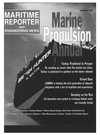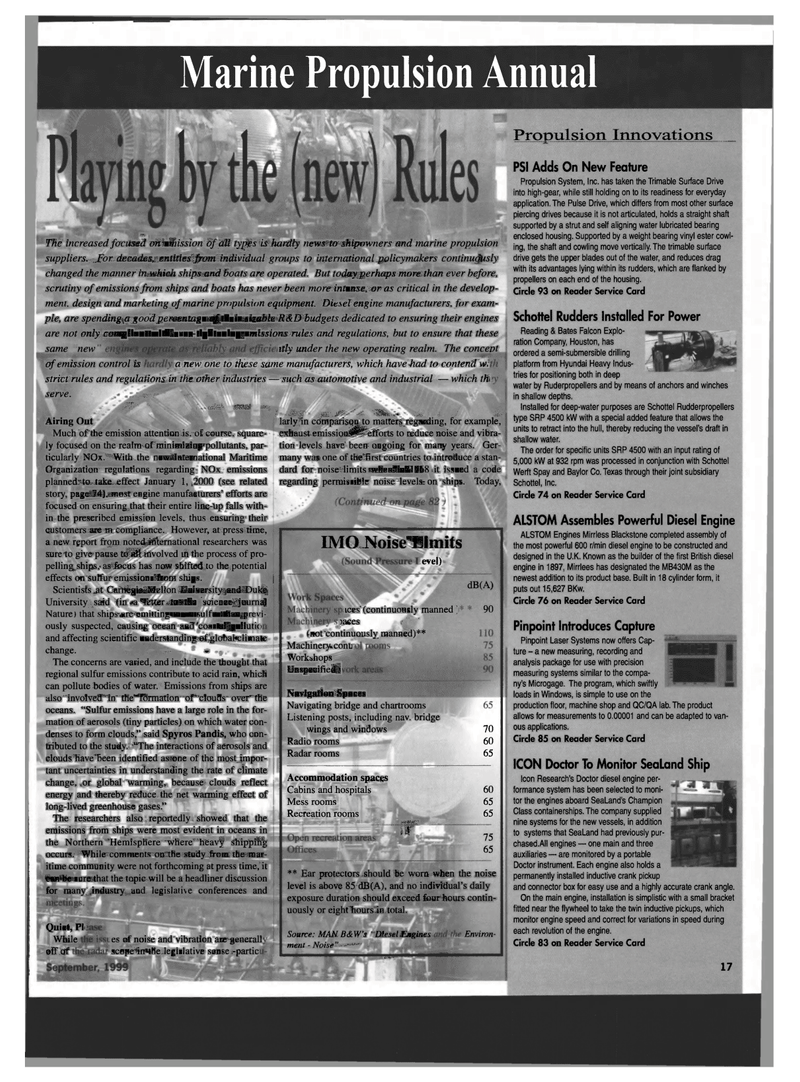
Page 19: of Maritime Reporter Magazine (September 1999)
Read this page in Pdf, Flash or Html5 edition of September 1999 Maritime Reporter Magazine
Marine Propulsion Annual
The increased fociisek oh eihission df till ty^s is hardly news to shipowners and marine propulsion suppliers. For decades, entities from individual groups to international policymakers continuously changed the manner in which ships and Boats are operated. But today perhaps more than ever before, scrutiny of emissions from ships and boats has never been more intense, or as critical in the develop- ment. design and marketing of marine propulsion equipment. Diesel engine manufacturers, for exam- pie, are spending a good percentage of their sizable R&D budgets dedicated to ensuring their engines are not only compliant with ever-tightening emissions rules and regulations, but to ensure that these itly under the new operating realm. The concevt same new of emission control is a new one to these same manufacturers, which have had to contend w, strict rules and regulations in the other industries — such as automotive and industrial — which th serve. • -
L _ * •jgHfir gfa]
Airing Out
Much of the emission attention is. of course, square- ly focused on the realm of minimizing pollutants, par- ticularly NOx. With the new International Maritime
Organization regulations regarding NOx emissions planned to take effect January 1, 2000 (see related story, page 74), most engine manufacturers' efforts are focused on ensuring that their entire line-tip falls with- in the prescribed emission levels, thus ensuring their customers are mxompliance; However, at press time, a new report frgpi note<§Mtern^tional researchers was sure to give pause tcjlifwivolved iff the process of pro- pelling, ships, as focus has now-shifted; to the potential effects on sulftir emissions from ships.
Scientists at Carifegie Mellon University and Dui||
University said (in aTetter to the'science journal
Nature) that ships are emitting more sulfur than pi t \ i- ously suspected, causing ocean and coastal pollutk and affecting scientific understanding of global climate change. **•*
The concerns are varied, and include the thought that regional sulfur emissions contribute to acid rain, which can pollute bodies of water. Emissions from ships are also involved in the formation of clouds over the oceans. "Sulfur emissions have a large role in the for- mation of aerosols (tiny particles) on which water con- denses to form clouds," said Spyros Pandis, who con- tributed to the study. "The interactions of aerosols and clouds have been identified as one of the most impor- tant uncertainties in understanding the rate of climate change, or global Warming, because clouds reflect energy and thereby reduce the net warming effect of long-lived greenhouse gases."
The researchers also reportedly showed that the emissions from ships were most evident in oceans in the Northern Hemisphere where heavfSKipJ)iI%
T-Mm jjMsr ^s^tm^msf ?! a— larly in comparison to matter§ regarding, for example, exhaust emission J8|5ffcrts to reduce noise and vibra- tion levels have been ongoing for many years. Ger- many was one of the first countries to introduce a stan- dard for noise limits when in 1968 it issued a code regarding permissible noise levels on ships. Today, 1 occurs. While comments on the study from the mar- itime community were not forthcoming at press time, it tan be sure that the topic will be a headliner discussion for many industry and legislative conferences and
Quiet, PI
While off erf es of noise and vibration are general! scope in the legislative sense -partic
IMO Noise Limits evel) ices (continuously manned ^ paces Sm" HflHH (not continuously manned)**
Machinery,.conti
Workshops
Unspecified!
Navigation Spaces
Navigating bridge and chartrooms
Listening posts, including nav. bridge wings and windows
Radio rooms
Radar rooms dB(A) 90 70 60 65
Accommodation spaces
Cabins and hospitals
Mess rooms
Recreation rooms 60 65 65 w 75 65 ** Ear protectors should be worn when the noise level is above 85 dB(A), and no individual's daily exposure duration should exceed four hours contin- uously or eight hours in total.
Source: MAN B&W's ment - Noise" ^Wfm ••Diesel Engines
Pirns
Environ-
Propulsion Innovations
PSI Adds On New Feature
Propulsion System, Inc. has taken the Trimable Surface Drive into high-gear, while still holding on to its readiness for everyday application. The Pulse Drive, which differs from most other surface piercing drives because it is not articulated, holds a straight shaft supported by a strut and self aligning water lubricated bearing enclosed housing. Supported by a weight bearing vinyl ester cowl- ing, the shaft and cowling move vertically. The trimable surface drive gets the upper blades out of the water, and reduces drag with its advantages lying within its rudders, which are flanked by propellers on each end of the housing.
Circle 93 on Reader Service Card
Schottel Rudders Installed For Power
Reading & Bates Falcon Explo- ration Company, Houston, has ordered a semi-submersible drilling platform from Hyundai Heavy Indus- tries for positioning both in deep water by Ruderpropellers and by means of anchors and winches in shallow depths.
Installed for deep-water purposes are Schottel Rudderpropellers type SRP 4500 kW with a special added feature that allows the units to retract into the hull, thereby reducing the vessel's draft in shallow water.
The order for specific units SRP 4500 with an input rating of 5,000 kW at 932 rpm was processed in conjunction with Schottel
Werft Spay and Baylor Co. Texas through their joint subsidiary
Schottel, Inc.
Circle 74 on Reader Service Card
ALSTOM Assembles Powerful Diesel Engine
ALSTOM Engines Mirrless Blackstone completed assembly of the most powerful 600 r/min diesel engine to be constructed and designed in the U.K. Known as the builder of the first British diesel engine in 1897, Mirrlees has designated the MB430M as the newest addition to its product base. Built in 18 cylinder form, it puts out 15,627 BKw.
Circle 76 on Reader Service Card
Pinpoint Introduces Capture
Pinpoint Laser Systems now offers Cap- ture - a new measuring, recording and analysis package for use with precision measuring systems similar to the compa- ny's Microgage. The program, which swiftly loads in Windows, is simple to use on the production floor, machine shop and QC/QA lab. The product allows for measurements to 0.00001 and can be adapted to ous applications.
Circle 85 on Reader Service Card
ICON Doctor To Monitor SeaLand Ship
Icon Research's Doctor diesel engine per- formance system has been selected to moni- tor the engines aboard SeaLand's Champion
Class containerships. The company supplied nine systems for the new vessels, in addition to systems that SeaLand had previously pur- chased.AII engines — one main and three auxiliaries — are monitored by a portable
Doctor instrument. Each engine also holds a permanently installed inductive crank pickup and connector box for easy use and a highly accurate crank angle.
On the main engine, installation is simplistic with a small bracket fitted near the flywheel to take the twin inductive pickups, which monitor engine speed and correct for variations in speed during each revolution of the engine.
Circle 83 on Reader Service Card 17 van-

 18
18

 20
20
